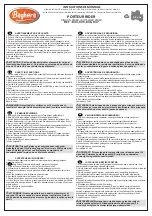
12
!
Changing the Spur Gear
Changing the Pinion Gear/Gear Ratio
Setting the Gear Mesh
Reassembly
Steering Servo Installation/Removal
Receiver/Speed Control (ESC) Installation/Removal
When running aftermarket motors, check with the motor manufacturer for correct gearing.
Never over-gear the motor as it can cause overheating, damaging it and the speed control.
Warning
The motor screws should be slightly loose. Slide the motor back allowing the pinion gear to
mesh with the spur gear. Snug (not tight) the bottom motor screw and try rocking the spur back
and forth. There should be a slight bit of movement before the motor is forced to turn over. If
not, pull the top of the motor forward slightly and recheck. If there is too much slop between the
gears, push the top of the motor back. When set properly the wheels can be spun forward freely
with very little noise. Make sure to tighten both motor screws before running.
Unplug the servo lead from the receiver. Remove the four small screws that secure the servo mount/chassis brace to
the chassis. Use a screwdriver or small pliers to pop the steering link off of the servo, so it can be removed before
installing the servo saver on a new servo plug the servo into the receiver and turn the radio ON to let it center and allow
for the servo saver to be located properly. Replace in the reverse sequence used to remove it.
Unplug the power lead, motor leads and steering servo. Do not attempt to open the receiver or electronic speed
control (ESC) as only a factory technician has the proper tools and parts to make any repairs necessary. The
receiver and ESC are mounted with double-sided foam tape. Use your thumb and index finger at the bottom of the
front corners to pull them from the mount. If this is difficult, ask for help. If necessary, carefully use a large flat blade
screwdriver between the unit and the mount to pry it loose. Make sure you remove any left over foam or adhesive
before remounting with common servo tape or hobby type foam tape.
If you are replacing the spur gear with one of a different size (number of teeth), you must first loosen (do not remove)
the two screws that secure the motor and slide it back slightly. Remove the 3mm nut at the end of the slipper shaft and
all of the slipper parts on the outside of the spur gearas well as the old gear. Place the new spur gear into position and
replace the slipper parts. If you have changed the size of the spur, see Setting the Gear Mesh below. After you have
changed the spur gear, you will have to adjust the slipper as described elsewhere.
Replace the idler gear and shaft into the center of the same right side of the gearbox. Replace the large bevel
gears into the bearings in both the left and right side gear box half. Place the center diff gear with the three small
bevel gears already installed into the center so the bevel gears seat with each other. Replace the screws and
reinstall the rebuilt gearbox using the steps in reverse order that were used to remove it.
Before you change the pinion gear ask yourself why you are doing it. In general, if you change to a larger pinion the top
speed will improve but you will see less acceleration and run time, This can also lead to the motor failing due to excess
heat and load which is not covered by the warranty. This would only be advisable for really long rack layouts with few
tight turns. Changing to a smaller pinion will give you quicker acceleration and possibly a bit longer run time. This would
be good for short layouts or when running hotter motors. The pinion on the Mini Sprint offers the best balance of both. To
change the pinion, loosen the motor screws, and slide the motor back. Place the new pinion on the end of the motor
shaft, so the set screw is located over the flat on the shaft. Position it so the teeth line up with the spur gear and secure
by tightening the set screw. See Setting the Gear Mesh below.

































